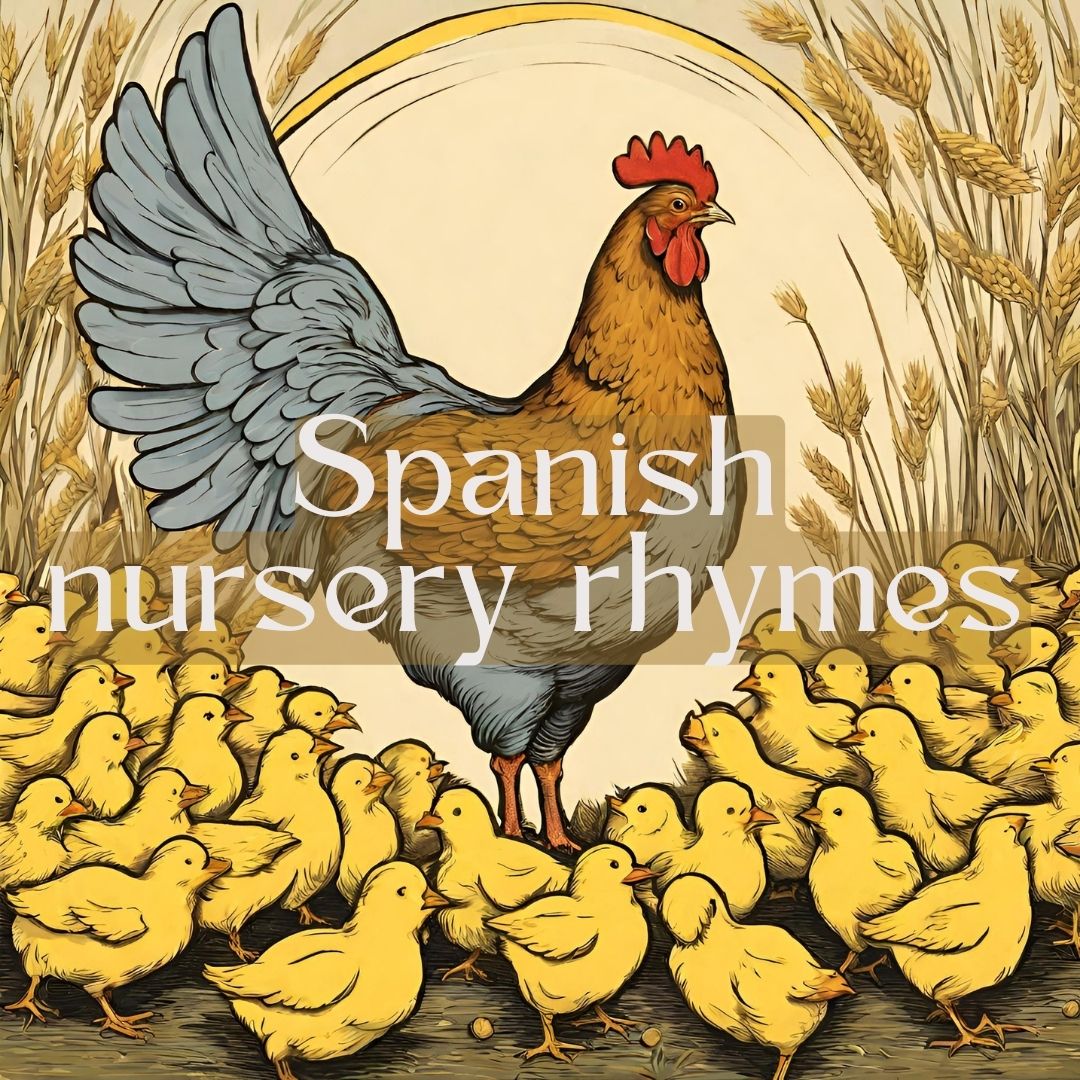The Charm of Spanish Nursery Rhymes and Lullabies

Get our free email course, Shortcut to Conversational.
Have conversations faster, understand people when they speak fast, and other tested tips to learn faster.
More infoNursery rhymes and lullabies are an integral part of childhood across the world, and Hispanic culture is no exception. These simple and melodious verses have been cherished for generations, handed down from parents to children. Not only do they serve as a delightful way to engage and bond with young ones, but they also provide an excellent opportunity for language learning.
Spanish nursery rhymes offer a delightful and effective way for parents and educators to introduce children to the Spanish language. Their poetic simplicity and their catchy melodies make it easy for young learners to engage with the language in a fun and interactive way. They provide numerous benefits, such as vocabulary building, developing proper pronunciation and intonation, and creating a cultural connection with the diverse traditions and stories of the Spanish-speaking world.
In addition, they’re always a fun bonding activity for families or in a classroom. So for today’s post, we’re introducing 15 of the most well-known nursery rhymes and lullabies in Spanish!
Types of nursery rhymes in Spanish
Before we delve deeper into the magic of nursery rhymes and lullabies, let’s clarify how to refer to them in Spanish. Nursery rhymes can be translated as canciones infantiles or simply rimas infantiles. On the other hand, lullabies translate to nanas or canciones de cuna.
While the terms are similar, canciones de cuna specifically refer to the soothing songs sung to babies so they fall asleep, whereas canciones infantiles encompass a broader range of children’s songs and rhymes.
15 classic Spanish nursery rhymes and lullabies
Without further ado, let’s sit tight and learn some classic nursery rhymes in Spanish!
We provide the original texts of the Spanish lullabies and rhymes here, along with our own English translations.
Los pollitos dicen – The little chicks say
This classic Spanish nursery rhyme tells the story of little chicks and their mother hen. It’s a favorite among young children for its simple lyrics and cute imagery.
| Spanish nursery rhyme | English translation |
| Los pollitos dicen, “pio, pio, pio,” cuando tienen hambre, cuando tienen frío. La gallina busca el maíz y el trigo, |
The little chicks say, “peep, peep, peep,” when they are hungry, when they are cold. The hen looks for corn and wheat, |
La cucaracha – The cockroach
This nursery rhyme in Spanish originated in Mexico, and while it has many variations across Latin America, it often features the misadventures of a poor cockroach.
| Spanish nursery rhyme | English translation |
| La cucaracha, la cucaracha, ya no puede caminar, porque le falta, porque no tiene la patita principal. Una cucaracha grande |
The cockroach can no longer walk because it lacks because it’s missing it’s main leg. A big cockroach |
Estrellita, ¿dónde estás? – Little star, where are you?
This Spanish lullaby is the adaptation of the classic “Twinkle, twinkle, little star.”
| Spanish nursery rhyme | English translation |
| Estrellita, ¿dónde estás? Quiero verte titilar. En el cielo sobre el mar, un diamante de verdad. Estrellita, ¿dónde estás? Quiero verte titilar. |
Little star, where are you? I want to see you twinkle In the sky above the sea a real diamond Little star, where are you? I want to see you twinkle |
La vaca Lola – Lola the cow
A cheerful song that introduces children to a lovable cow named Lola, this rhyme is adored for its catchy tune and repetitive lyrics.
| Spanish nursery rhyme | English translation |
| La vaca Lola, la vaca Lola, tiene cabeza y tiene cola. La vaca Lola, la vaca Lola, tiene cabeza y tiene cola. Y hace muuu. |
Lola, the cow, has a head and a tail. Lola, the cow, has a head and a tail. And goes moo. |
La vaca lechera – The dairy cow
Yet another Spanish nursery rhyme about cows, this one describes a special cow that gives sweet condensed milk! Just so you know, when it says that the cow is “salada” doesn’t mean that the dairy it gives is salty, but rather that the cow is “unlucky.”
| Spanish nursery rhyme | English translation |
| Tengo una vaca lechera, no es una vaca cualquiera. Me da leche condensada. Ay, ¡qué vaca tan salada! Tolón tolón, tolón tolón. Un cencerro le compraron |
I have a dairy cow, not just any cow. She gives me condensed milk. Oh, what a salty cow! Tolon, tolon, tolon, tolon. They bought her a cowbell |
Duérmete, niño (El Coco) – Sleep, boy (The Boogeyman)
Spanish lullabies often have elements of fear to convince children to go to bed. The main character of this one is el Coco, the Spanish equivalent of the Boogeyman.
| Spanish nursery rhyme | English translation |
| Duérmete niño, duérmete ya, que viene el coco y te llevará. Duérmete niño, |
Sleep, child, sleep now, or the bogeyman will come and take you away. Sleep, child, |
Tengo una muñeca – I have a doll
This one is a funny song about a doll who gets sick and learns math.
| Spanish nursery rhyme | English translation |
| Tengo una muñeca vestida de azul, con zapatos blancos y medias de tul. La llevé a paseo, Esta mañanita Brinca la tablita Dos y dos son cuatro, |
I have a doll dressed in blue with white shoes and tulle stockings. I took her for a stroll This morning, Skip the hopscotch Two and two are four |
La lechuza – The owl
This popular Spanish nursery rhyme is usually sung when trying to prompt children to be quiet. It’s quite popular among school teachers and babysitters.
| Spanish nursery rhyme | English translation |
| La lechuza, la lechuza, hace shhh, hace shhh. Todos calladitos, como la lechuza que hace shhh, hace shhh. |
The owl goes shhh. Everybody quiet like the owl that goes shhh. |
Arroz con leche
This interesting song is a sweet rhyme that likens rice pudding to a wedding.
| Spanish nursery rhyme | English translation |
| Arroz con leche, me quiero casar con una viudita de la capital que sepa coser que sepa bordar que ponga la mesa en su santo lugar. Yo soy la viudita, |
Rice pudding I want to marry a widow from the capital that knows how to sew knows how to embroider, and set the table in its rightful place. I am the widow, |
A la nanita nana
Originally a carol composed in honor of the Baby Jesus, it later became a popular lullaby in Spanish. Often, Jesus’s name is replaced with mi niño (my boy) or mi niña (mi niña). This song is a bit long to be included here, so we’ll include the most popular verses.
| Spanish lullaby | English translation |
| A la nanita, nana, nanita, nana, nanita ea Mi Jesús tiene sueño, ¡Bendito sea, bendito sea! Fuentecilla que corre |
A la nanita, nana, nanita, nana, nanita ea My Jesus is sleepy, Bless Him! Little spring that flows, |
El elefante del circo – The circus elephant
Kids love to do a little dance pretending to be elephants when singing this charming song about an elephant that does tricks.
| Spanish nursery rhyme | English translation |
| El elefante del circo mueve sus patas así, es muy grande, muy pesado y no se parece a ti. Si le das un manicito, Gracias! |
The circus elephant moves its legs like this, it’s very big, very heavy and doesn’t resemble you. If you give it a little peanut, Thank you! |
Un elefante se columpiaba – One elephant was swinging
This is a popular counting rhyme in Spanish. It is often used to teach children numbers while having fun with the playful imagery of elephants swinging on a spider’s web. It can go on forever if you don’t stop singing!
| Spanish nursery rhyme | English translation |
| Un elefante se columpiaba sobre la tela de una araña, como veía que resistía fue a llamar a otro elefante. Dos elefantes se columpiaban |
One elephant was swinging on the web of a spider, since he saw that it held he went to call another elephant. Two elephants were swinging |
Duérmete, mi niño – Sleep, my child
This lovely lullaby is particularly popular in Venezuela. In fact, its melody is identical to that of Venezuela’s National Anthem. This remarkable connection exemplifies the profound cultural impact that Spanish lullabies can wield.
| Spanish lullaby | English translation |
| Duérmete mi niño, que tengo que hacer Lavar los pañales, hacerte de comer. Duérmase mi niño que tengo que hacer Lavar los pañales y hacerte de comer. Ese niño quiere que lo duerma yo, |
Go to sleep, my child, I have chores to do Wash the diapers and prepare your food Go to sleep, my child, I have chores to do Wash the diapers and prepare your food. That child wants me to lull him to sleep |
A la víbora de la mar – The sea snake
This one is a traditional Mexican children’s game and song that involves forming a circle of participants who move in a coordinated manner while singing the song. The game can be played at gatherings and parties and is a fun way for children to engage in physical activity while singing along.
| Spanish nursery rhyme | English translation |
| A la víbora, víbora de la mar, por aquí pueden pasar. Los de adelante corren mucho, los de atrás se quedarán. |
To the sea snake, you can pass through here. Those in the front run fast, those in the back will be left behind. |
Arrorró, mi niño – Lullaby, my child
This is a traditional Spanish lullaby that is often sung to soothe and comfort babies and young children.
| Spanish lullaby | English translation |
| Arrorró, mi niño, arrorró, mi Sol, arrorró, pedazo de mi corazón. Este niño lindo Este niño lindo |
Lullaby, my child, lullaby, my Sun, lullaby, piece of my heart. This lovely child This lovely child |
Conclusion
That was fun, wasn’t it? The world of Spanish nursery rhymes and lullabies is a treasure trove of cultural richness, educational value, and pure childhood joy. These timeless verses have transcended generations, serving not only as enchanting melodies but also as a gateway to language learning and a source of endless fun for children and adults alike.
Through the simplicity of their lyrics and the catchiness of their tunes, Spanish nursery rhymes offer an effective and engaging way for parents, educators, and caregivers to introduce children to the Spanish language.
So, as we wrap up our exploration of these charming Spanish nursery rhymes, here’s a friendly nudge: don’t just read about them, sing them! These rhymes are your ticket to a world of laughter, learning, and connection. Sing them loud, sing them proud, and keep the magic alive for generations to come!



